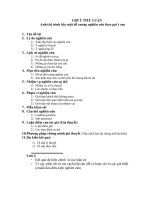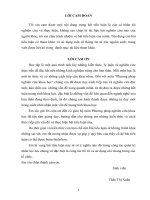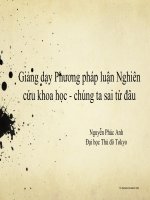Bài tự luận phương pháp luận nguyên cứu khoa học EHOU
Bạn đang xem bản rút gọn của tài liệu. Xem và tải ngay bản đầy đủ của tài liệu tại đây (78.47 KB, 4 trang )
HANOI OPEN
UNIVERSITY
MÔN HỌC: PHƯƠNG PHÁP LUẬN NGHIÊN CỨU
KHOA HỌC
Họ Và Tên: Khổng Hồng An
Ngày sinh: 01-04-1996
Lớp + MSSV: FDNBD217A / 22C7137D1035
BÀI TẬP TỰ LUẬN
Đề số 1:
Câu 1: Nêu văn vắn tắt nội dung Các bước/ Trình tự thực hiện đề tài nghiên cứu khoa học (4 điểm).
Câu 2: Lấy ví dụ 01 đề tài nghiên cứu khoa học cụ thể, đúng chuyên ngành Ngôn ngữ Anh để minh
hoạ cho các các bước/ trình tự thực hiện đề tài nghiên cứu khoa học ở trên. (6 điểm).
Bài làm
Câu 1:
Step 1: Selecting a scientific topic.
The beginning of the research, first of all, we need to find:
The choice of scientific topic must come from the selection of scientific facts/problems.
The question is asked when the person research contradicts the limitations of existing
scientific knowledge and requirements. The bridge develops that knowledge at a higher level.
- A research topic must meet the several criteria as given below:
* Has the scientific value
* Has the realistic value/application value
* Is it necessary/ urgent /emerging
* Is it suitable for the current research resources/ research conditions
* Is it appropriate to the expertise of the researchers
* Are the researchers enthusiastic with the topic
- Then we give the name of the research topic, which include all information such as: Basis of research
methodologies, research subjects, scope and application of the research
Step 2: Formulating a scientific thesis.
- Scientific facts: A scientific event is a thing or phenomenon that contains demanding
problems ask for explanation by scientific knowledge and by observational methods or
scientific experiments.
- Research problem: It includes two classes of problem. The first one is the nature of things to
be sought. The second class problem is the problem of research methodology.
Situations of scientific problems. There are three situations that can happen: Situation 1:
There is a research problem. Situation 2: No problem or no problem, and the last situation is
that there was a problem, but after reviewing there is not any problem (It called “fake –
problem”).
Methods for detecting scientific problems.
- Scientific hypothesis: a preliminary statement, a hypothetical conclusion about the nature of
things given by the researcher to prove or disprove.
-
Step 3: METHODS OF PROVING A SCIENTIFIC THESIS
- In this step, we must verify the hypothesis using the qualified evidence and correct
methodologies.
- Evidence: Could be some proved theories, or the results of previous events, or previous
studies.
- The logical structure of proofs. It consists of 3 constituent parts: hypothesis, argument, and
method.
- Methods of proving the thesis: Approach, documentary research methods, non –
experimental methods…etc.
- Collecting information/data: Through various ways: internet, survey, expert interview,
people interview, conducting experiment, reading literature reviews, observe methods.
- Data analyzing: using software, tools
Step 4: Presentation of a scientific thesis
In this step, we start to write all the above in appropriate logical structure. Depend on different type of
research product, we have different structure.
For the research topic, it should include these parts:
1. Introduction:
Brief introduction of the research/studies. Introduction should mention about the reason to conduct the
study, what are the methodologies used in the studies, and the final results after doing the research
activities.
2. Literature review
This part is to give some of the previous studies related to the research topic. It also shows the gap in
research that encourage the author to conduct this research.
3. Aim and objectives of the research
This part is to point out the aim and objectives, along with the specific research questions that need to
be solved and answer throughout the research.
This part also includes the research hypothesis.
4. Methodologies
This part should mention very clearly all methodologies applied in the studies, why and how it has been
used to get the data and get the evidence to prove the research hypothesis.
5. Results
After doing many activities, the author will display all of the data and results in this part, and describe
the data to support the hypothesis.
6. Conclusion and discussion
This part includes the conclusion of the author about the research problems, how the results help solve
the problem. The author could also raise some more question for others to discuss about the research
topic, mention some advantages and disadvantages of the research and give recommendation for further
relative studies.
Câu 2
Research topic: A study on common English written errors made by first/ second year students of
English major at Hanoi Open University
Step 1: Selecting the research topic.
- The majority of first- and second-year student of English major have their score below 7, this could
be observed through their midterm and end-term exam’s results.
- Among the 4 skills: Reading, speaking, writing, listening, the author believe that writing skill have the
lowest average score.
- This is the problem not only from the student, but also from the teachers. And this could lead to the
difficulty for student later when they graduate and find a job required English Skill.
- To improve the situation and help the student, there is necessary to conduct a study to see what are the
common errors made by first/ second year students of English major?
- Therefore, the authors choose the topic: A study on common English written errors made by first/
second year students of English major at Hanoi Open University
Step 2: Forming of scientific research thesis.
- This study aims to identify the common mistakes made by first-year and second-year student of
English major at Hanoi Open University
- After identifying the mistakes, this study points out what is the problem from the lecture that make
the student do the same mistakes many times
- Do the errors affect the student performance seriously?
- What should be done to improve the situation
- Assumption given: Common errors made by student are come from the influence of speaking style to
the writing style.
Step 3: Proving the scientific research statement.
- Collect the data of common errors from the student exams
- Conduct a survey with a group of 1000 students
- Interview students, teachers
- Find data, read some previous studies related to this topic
- Analyzed data using Excel and other tools
Step 4: Illustrating the scientific research statement.
1. Introduction:
This study focuses on the common errors made by first/ second year students of English major at Hanoi
Open University. A survey has been conducted among 1000 first, second-year student to evaluate how
student recognize their mistake in written. Besides, all student’s writing exam have been collected to
analyze the common errors.
2. Literature review
3. Aim and objectives of the research
- This study aims to identify the common mistakes made by first-year and second-year student of
English major at Hanoi Open University
- After identifying the mistakes, this study points out what is the problem from the lecture that make
the student do the same mistakes many times
- Do the errors affect the student performance seriously?
- What should be done to improve the situation
4. Methodologies
- Collect the data of common errors from the student exams
- Conduct a survey with a group of 1000 students
- Interview students, teachers
- Find data, read some previous studies related to this topic
- Analyzed data using Excel and other tools
5. Results
- The most common errors are the grammar, because in speaking, the student pay less attention to the
grammar and the communication efficiency is still good. People can also understand each other in the
context of grammar mistakes. But in writing, the grammar plays the bigger role the contribute to the
correct meaning of the sentence.
- The second most common errors are the vocabulary. There are 2 skills affect to the rate of this errors
in writing, which are speaking and listening. If the student spell or hear the word not correctly, there
will be higher of them making the same mistake in writing.
6. Conclusion and discussion
In conclusion, the teacher should pay more attention when teach speaking for the student, especially in
grammar and pronunciation. Besides the university should organize more activity for student that
encourage them to use all skill of English at the same time, so that they can recognize their common
mistake and correct it when writing.









